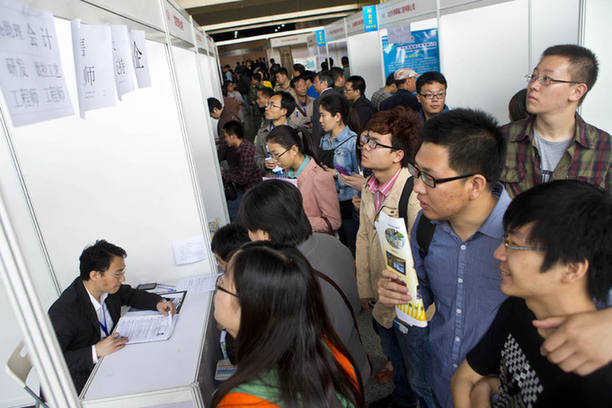Build a Capital Economic Circle for Coordinated Development
 |
|
More than 200 institutions and companies show up at the Beijing-Tianjin-Hebei Job Fair in Beijing on April 23, 2014. |
Integrated Transportation System
In April of 2014, Tianjin Airport opened a terminal at Beijing South Railway Station. Passengers in Beijing can now take the express train to Tianjin Railway Station and then take a bus to Tianjin Binhai International Airport, both free of charge. The trip is 30 minutes shorter than to Beijing Capital International Airport. What brings Beijng and Tianjin closer is the Beijing-Tianjin High-Speed Rail that started operation in 2008. It is China’s first inter-city high-speed rail for trains traveling at more than 300 kilometers per hour, as well as China’s first passenger high-speed line. The travel time between the two cities is now only 29 minutes.
In the Beijing-Tianjin-Hebei region, besides the Beijing-Tianjin high-speed rail, there are other high-speed lines such as the Beijing-Shijiazhuang passenger rail line, the Tianjin-Qinhuangdao high-speed line and the Beijing-Shanghai high-speed railway. The travel time between major cities, such as Beijing-Tianjin, Beijing-Shijiazhuang, Tianjin-Tangshan and Tianjin-Qinhuangdao is around one hour, forming a “one-hour” city circle.
Roadways in this region are also very convenient. The major urban centers are joined by an efficient network of major highways. Hebei and Beijing have six highway interfaces, while Hebei and Tianjin have nine. In 2013, an electronic toll collection system went into operation covering Beijing, Tianjin, Hebei, Shanxi and Shandong, allowing drivers to pay expressway tolls without stopping.
In February of 2014, President Xi Jinping explicitly put forward seven requirements while listening to the work reports on the integrated development of Beijing, Tianjin and Hebei. Regarding transportation, Xi urged that integrated transportation should be a priority and efforts should focus on building a modern transportation network. He suggested accelerated construction of a comprehensive transportation network featuring connectivity, high speed, convenience, efficiency, safety, high capacity and low cost. In 2014, the three localities will communicate on transport infrastructure construction plans and accelerate the pace of transportation integration.
According to the plan, by 2020, a 9,000-kilometer network of expressways and a major city three-hour road traffic circle will be built in the region. Beijing and Tianjin will be united by the old Beijing-Tianjin-Tanggu and Beijing-Tianjing highways, as well as the Beijing-Taipei Highway which is expected to be finished by the end of 2014. Then Beijing and Tianjin will be just an hour apart by road. In the larger Beijing-Tianjin-Hebei area, it will take less than three hours from either Beijing or Tianjin to reach major cities around Hebei Province, such as Baoding, Tangshan, Huanghua and Cangzhou.
The integrated transportation system is taking shape in the area, including the Beijing outer expressway ring, six transportation channels that extend in six directions with Beijing as the center, two airports – Beijing Capital International Airport and another new airport in Beijing, as well as five seaports, namely Qinhuangdao Port, Jingtang Port, Caofeidian Port, Tainjin Port and Huanghua Port.

